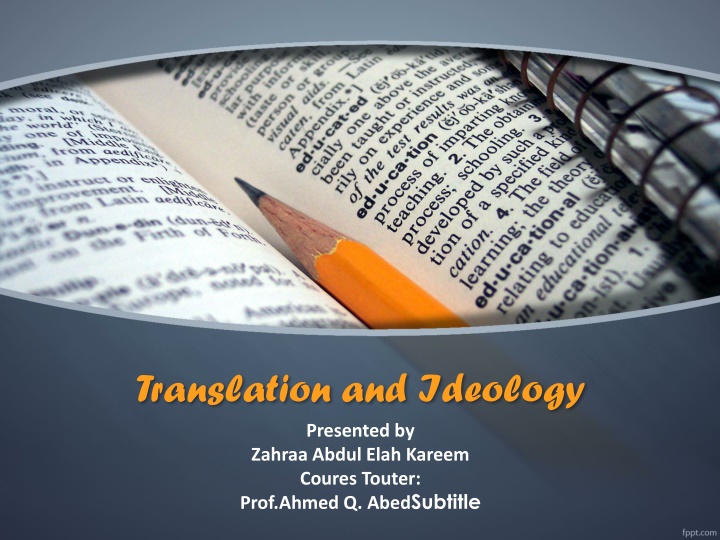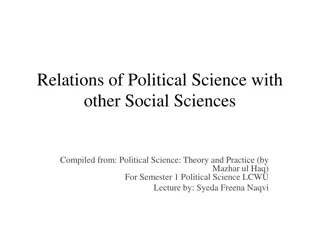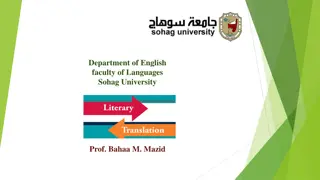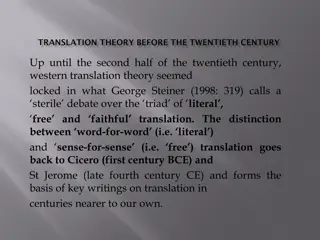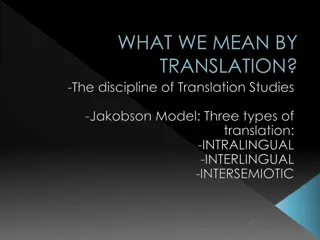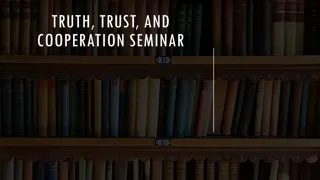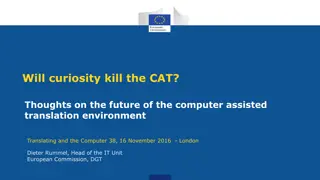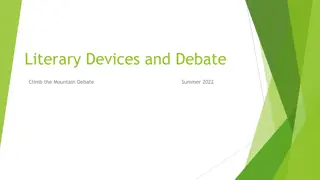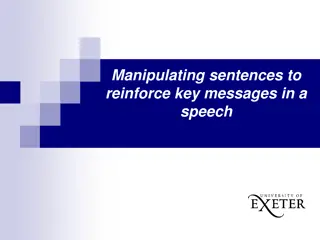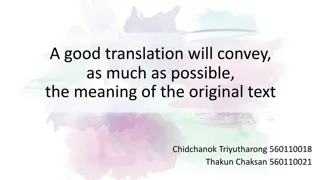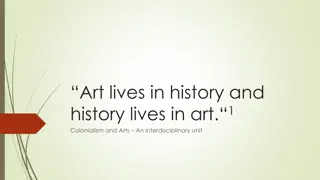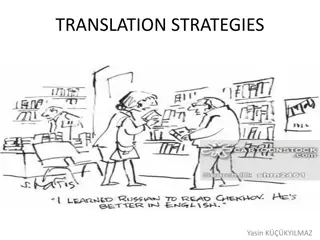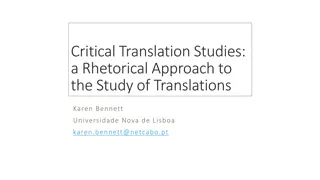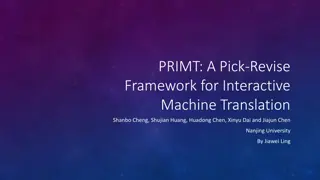Translation and Ideology: The Impact of Interpreting on Political Speeches
In the realm of political speeches, translation and interpreting play crucial roles in conveying speakers' ideas to foreign audiences. Explore the complexities and influences of interpreter renditions on communication of intentions and devices used in framing speeches. Delve into the significance of language in shaping audience perception and understanding in different contexts, such as courtroom interpreting and live broadcast simultaneous interpreting.
Download Presentation

Please find below an Image/Link to download the presentation.
The content on the website is provided AS IS for your information and personal use only. It may not be sold, licensed, or shared on other websites without obtaining consent from the author.If you encounter any issues during the download, it is possible that the publisher has removed the file from their server.
You are allowed to download the files provided on this website for personal or commercial use, subject to the condition that they are used lawfully. All files are the property of their respective owners.
The content on the website is provided AS IS for your information and personal use only. It may not be sold, licensed, or shared on other websites without obtaining consent from the author.
E N D
Presentation Transcript
Translation and Ideology Presented by Zahraa Abdul Elah Kareem Coures Touter: Prof.Ahmed Q. AbedSubtitle
Introduction The discourse of political speeches is a highly intentional form, geared to maximize audience constituency. A range of rhetorical and communicative devices tends to characterize such discourse, their frame of reference professional speech-writers, to be delivered: at certain times, in certain places and directed to an identified group of people. sharpened by
When both speaker and audience share the same language, such speeches are usually assessed in terms of the perceived worth of the agendas that they adopt, supported by the powerful impact of communicative devices. their rhetorical and When they are delivered in a language foreign to the audience, the introduced presence of the interpreter becomes an active agent in the process of reception.
It is, of course, through the processes of translation and interpreting that speakers ideas, beliefs, and points of view are reflected to their foreign audience. For example, judges in the context of courtroom interpreting, prefer to assume that the filtering process of interpreting is as transparent as possible, a clear window intentions. onto speakers
Interpreter renditions involve both conscious and unconscious intervention, which, whatever the motivation may be, affects the communication both of intentions and the devices that frame and communicate those intentions. These interventions spring in the main from a desire on the part of the interpreter to frame the speech within its context, to ensure that the audience recognizes its relationship with the speaker, to know the extent to which it is considered as other within the ideas, beliefs, and points of view expressed by the speaker.
The issue becomes more complicated and, given the scale of audiences involved, even more influential in the case of live broadcast simultaneous interpreting where the interpreter has no time for further thinking or revision, and what is said cannot be retrieved, modified or reproduced in a revised version.
Re-Visiting the Interpreters Role The considered instrumental task of rendering linguistic messages (i.e. a bilingual re-speaker) into being an active participant in the act of cultural exchange that operates within the gap between cultures. Interpreting is an: 1) interlingual, 2) intercultural oral or signed mediation in other words, the interpreter is the interlingual and intercultural mediator who controls the conditions of communication between participants. role of to the have interpreter shifted is increasingly the from mere
3) contractual mediation, that underlines the broader relationship in which the communicative event between participants takes place. cognitive Poshhacker s model of mediation contractual intercultural
Hatim and Mason hypothesize that translators (and interpreters) as mediators intervene in the transfer process, feeding their knowledge and beliefs into the processing of a text . Discourse Van Dijk s model of manipulating Society Cognitive
The manipulator is: 1) assigned a particular social position that is different-privileged-from that of his recipients (whether dominated or clients), 2) expressing power or abuse of power through text and oral communication or even visual messages. Crucially, s/he engages in communication and interaction with the interpreting event to affect their mental models (experiences). recipients of the
In the context of manipulation, as far as interpreting as a profession is concerned, the institutions for which interpreters work have a marked influence on their performance. The interpreter must obey his institution s policy so as to stay in work. The manipulative power applied by his institution makes the interpreter a consumer of ideologies, digested and stored in his mind and then reproduced as though his or her own.
Ideology in Translation Hatim and Mason have helped to advance our understanding of the way ideology shapes discourse and the way discourse practices help to maintain, reinforce or challenge ideologies . Their conclusion is that there is an undeniable connection between ideology and discourse. They see ideology as the tacit assumptions, beliefs and value systems which are collectively shared by a social group while discourse is, , institutionalized modes of speaking and writing which give expression to particular attitudes towards areas of socio- cultural activity .
The implication is that to trace ideology is to carry out an analysis of discourse. They proceed to outline the model that they will use to discern and track ideologically- generated variations in translation. The model carefully differentiates between the ideology of translating and the translation of ideology. translator mediation is put under examination to assess how it ranges between low and high degrees of mediation in order to affect the transfer of ideologies translation decisions are examined to identify the overriding translational strategy (i.e. foreignization or domestication)
As a human being living in a certain society at a particular time, there are specific constraints and obligations that simultaneous interpreters cannot avoid, such as the ethnic, social, or political determinants that are rooted in their knowledge of the world, and the interpretants arising determinations are reflected within their work, again as we have noted whether consciously or unconsciously. from these
The Ideology of Translating Translator choice has always implied a certain ideology. To choose between apparently essential strategic positions - for example, free vs. literal, formal vs. dynamic, or communicative vs. semantic - in practice, implies choices that reveal ideological positions. Hatim and Mason review these critical functions of ideology, acknowledging that Venuti is the first scholar to demonstrate consequences of this choice through what they consider to be the dichotomy he establishes between foreignizing translation. the ideological and domesticating
Schleiermacher saw translation strategy as serving a critical ideological function within the receiving audience (in this case, the relationship between France and Germany as political and cultural rivals was the central issue). Schleiermacher famously puts forward the idea that there are two primary translating strategies: 1) [e]ither the translator leaves the author in peace, as much as possible, and moves the reader towards him; or 2) leaves the reader in peace, as much as possible, and moves the author towards him
Venuti offers his dichotomy of foreignization and domestication, where foreignization is seen as an ethnodeviant pressure on these values to register the linguistic and cultural differences of the foreign text, sending the reader abroad while domestication is characterized as an ethnocentric reduction of the foreign text to target language cultural values, bringing the author back home .
The Translation of Ideology Hatim and Mason investigate a number of linguistic features that account for the translator intervention, including recurrence, parallelisms, overlexicalization, style shifting, and cohesion to identify shifts in ideology. The samples they use consist of Farsi, Spanish, and French texts translated into English. They identify three degrees (minimal, maximal, and partial) of translator mediation. transitivity,
They relate translators interventions to their role as mediators, where mediation refers to the extent to which translators intervene in the transfer process feeding their knowledge and beliefs into the processing of texts . The simultaneous interpreter reproduces the speech of others, and in that capacity, in terms of the aforegoing theoretical positions, the simultaneous interpreter s agency inevitably entails significant degrees of manipulation.
This is not to say, of course, that the entire simultaneous outcome is manipulated, but violation of the speaker s ideological position may well be manipulated. In this sense there are two manipulators, 1) The first being the speaker, who intends to practice a kind of influence on his recipients, 2) The second being the translator or interpreter who, consciously or not, absorbs these manipulations (including ideologies) and portrays them according to what we have termed his or her mental models, in which modification or replacement is an ever-present likelihood.
This manipulation may be treated as a form of intervention that exceeds the communicative limits drawn by Hatim and Mason. Hatim and Mason try to justify intervention in terms of audience design or task . Communicative intervention cannot reasonably be the only instigator of such a performance. Manipulative intervention, the way in which we might charcterise this kind of intervention derives from recent research carried out in the wake of Hatim and Mason s contribution, especially under terms such as intervention , interventionist , or intervenient being .
These attempts that attempt to discern the subjective agency of the translator / interpreter are also based on Halliday s approach, but with greater emphasis on metafunction which Halliday labels as the intruder function. House draws attention to the dangerous decisions that the [m]anipulation or intervention for ideological, socio-political or ethical reasons, however, well- meant they may be in any individual case, are generally risky undertakings . the interpersonal translator takes:
In fact, as individuals who are members of different fields - i.e. family, groups and institutions translators/interpreters conforms frequently to a habitus comprising representations [that] are acquired through a lasting exposure to particular social conditions and conditionings, via the internalization of external constraints and possibilities . Translators / interpreters decisions and choices will vary depending on the kind of constraints that they fall under the work of unconscious
Halliday's approach represents a revolution in the way language is considered. It provides a complete account of the set of linguistic tools used in the analysis of language, an account in which linguistic choices are not arbitrary. In the case of professional interpreter agency this is clearly of significant value in that it implies that behind any linguistic choice there is a certain function that this choice fulfils. Systemic Functional Linguistic
According to Halliday , language is used to express three functions or as he prefers to call them metafunctions, namely the ideational, interpersonal and textual. In the ideational metafunction, language is used to express our experiences of the real world as well as of one s own consciousness, i.e. reflecting both outer and inner worlds through making use of transitivity and voice.
Within personal and social relationships are enacted concurrently. Language individual to communicate with society as well as to give him/her the opportunity to express and develop his/her personality, where mood and modality provide useful tools. Finally, within the textual metafunction, language helps to create coherent texts as well as providing the users of such texts with the ability to identify dislocations, such as vague or unrelated sentences. the interpersonal metafunction, here helps the
For instance: The police officer shot the old man. actor goal The old man was shot by the police officer. goal actor
Thank you Any question??
